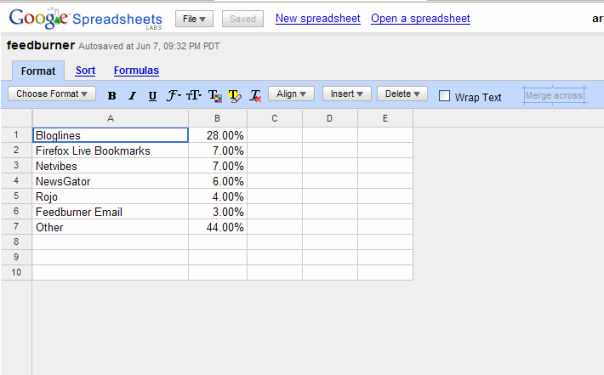As they say, a picture is worth a thousand words. Well, I save you about 950 words, instead let these two pics show you why I am staying with Zoho Sheet, despite all the hoopla around Google Spreadsheet. I imported the same Excel Spreadsheet into both Zoho and Google – here’s the comparison:


Which one is more pleasing to the eye I leave it to you, dear reader ![]() but what happened to my chart? Gone. Google Spreadsheet does not do charts. Of course we can pick a number of analytical functions from Excel that both Zoho and Google are missing.. but I am the average user, barely using 10% of Excel’s functionality. Charting, however, is not “advanced” functionality, at least not in my book. It’s a most expressive way to visually convey information – a must for me.
but what happened to my chart? Gone. Google Spreadsheet does not do charts. Of course we can pick a number of analytical functions from Excel that both Zoho and Google are missing.. but I am the average user, barely using 10% of Excel’s functionality. Charting, however, is not “advanced” functionality, at least not in my book. It’s a most expressive way to visually convey information – a must for me.
There is a reason why I am using pictures above, not the original spreadsheets: Google has no global share option, I have to invite specific emails. Zoho Sheet allows me to create a URL for global sharing, and it also has a handy feature of publishing just the chart, without the rest of the spreadsheet.
Considering my own usage pattern, Zoho is the hands-down winner. But of course the significance of Google releasing their spreadsheet is way beyond the current functionality, it’s further validation of Office 2.0, using personal productivity and collaboration tools directly on the Web. In the near future I will come back to the issue of Offline/Online, and what I believe the ideal balance is.
Update (6/7): As luck would have it, “Flickr is having a massage” right now, and my Zoho pic shows, Google does not. That’s certainly not what I wanted to present, bt Flickr is expected to be back to normal in 40-50 minutes.

 You Know Wikis Have Arrived When …. they become the feature post in your regular junk mail – this time from an Executive Recruiter firm:
You Know Wikis Have Arrived When …. they become the feature post in your regular junk mail – this time from an Executive Recruiter firm: (Updated)
(Updated)
Recent Comments